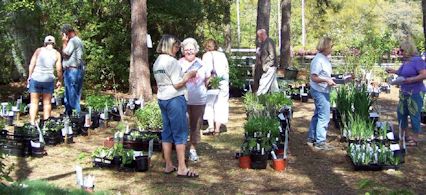 Shoppers will be able to choose from among dozens of different species of native plants. |
OCEAN – It’s spring gardening season and that Tuscan kale that looked so pretty in the gardening store last year didn’t make it and the flowering pear tree that you fussed over is looking sickly. Go native this year and save yourself time, money and hassles.
A good place to start the switch will be at the N.C. Coastal Federation’s main office in Carteret County on Saturday when the non-profit holds its 11th annual Native Plant Sale. You’ll be able to buy plants that will survive our humid summers and outlast our coastal winters.
Supporter Spotlight
“If you buy a species and put it in your garden that is native to your county it’s fine. It’s not going to care what the weather does and you don’t have to protect it in the winter,” said Joanie McLean, one of the owners of Mellow Marsh Farm, a nursery in Siler City that supplies some of the natives sold at the federation’s sale.
Notice how azaleas blossom like wildfire throughout an entire coastal city, or how the firewheel flowers thrive along the dunes no matter how hot it is at the beach. The secret: They belong there.
Native, or indigenous plants, evolved in the local area thousands of years ago along with the insects and the songbirds and, well, the whole food chain. By incorporating native plants in your garden and yard, you’re inviting the butterflies back home and much more.
In fact, the resiliency of native plants and their low maintenance are not the main reasons that the federation sells them or that Mellow Marsh Farm grows them. They are beneficial to the environment in many ways.
 Donna Snead |
 Randy Mason |
“The main purpose is to make people aware of the use of native plants,” said Rose Rundell, the federation’s administrative assistant and plant sale coordinator.
Supporter Spotlight
“This is a very serious issue to maintain the integrity of our ecosystem and our natural community,” said McLean. “When nonnative species are brought into an area they generally don’t find themselves in balance with the ecosystem and they get out of hand.”
Kudzu is a familiar example. In Japan, where Kudzu originates, the plant is not a problem. When it was brought to the Unites States, however, it became an invasive species. Without the checks and balances of its native ecosystem – diseases, herbivores, parasites — Kudzu populations exploded.
Today there are around 50,000 nonnative plant species in the United States and 4,300 are considered invasive, according to the U.S. Fish & Wildlife Service. Many of these plants were introduced to the U.S. when colonialists brought their favorite plants and animals to the New World.
In effect, when invasive plants outcompete native plants for natural resources, the native species can become displaced and in extreme cases extinct, according to the U.S. Fish & Wildlife Service.
“A lot of the Russian olive and privet are examples of shrub species that are nonnatives and have very effectively crowded out and caused the disappearance of native shrubs,” said McLean.
The absence of native plants is not an aesthetics issue; it affects the local food chain – the pollinators and the birds that depend on them as natural food sources. In fact, research shows that “native songbirds are suffering detrimental effects from eating the berries and seeds and fruits from nonnative shrubs that have been brought in and that they say have jumped out of gardens and now spreading through the woods,” said McLean.
It’s a house of cards or a domino effect — you mess with one link and you’re going to get trouble all the way up the line and all the way down the line,” said McLean.
At the federation’s plant sale, locals will be sure to find native plants from “straight” seed, not hybridized seed. Some horticulturist use the term “native plants” but clone species or cross two species in a greenhouse to get a phenotype, or look, that they like. “They come up with a plant that did not happen naturally in nature,” said McLean, which means that they often can’t reproduce.
 Flowering dogwoods will be just one of the many native trees that will be available. |
“We keep within 200 miles of the nursery and we collect seed from wild population,” she said.
Whether you’re using natives or nonnatives this year, planting improves air and water quality. All plants take carbon out of the air, which is one of the primary greenhouse gases. Also, plants not only filter polluted stormwater runoff by absorbing it to grow, but their roots create resistance to the flow of runoff, aerate the soil for draining water and prevent erosion.
A wet, boggy corner on your property can be transformed into a blossoming rain garden that filters water pollution. A rain garden is a depressed area with plants that acts like a bowl collecting rain water during a storm. It is a smart yard technique that can reduce stormwater runoff pollution – the number one source of pollution in our creeks, rivers and sounds – by 90 percent or more.
The federation encourages the use of native plants when building rain gardens because many native species can handle both extremes: standing water and severe drought. And, because native plants are adapted to the soil and climate, they generally require little to no fertilizer; and the less fertilizer we use, the less fertilizer leeches into water bodies causing harmful algae blooms.
At the plant sale there will be an array of grasses, perennials, shrubs and trees to choose from, including a host of plants ideal for rain gardens. Each plant comes with a fact sheet that lists its common name, description, growing conditions, care, landscape uses and wildlife benefits. Members of the federation will receive a 10 percent discount, and others will have the opportunity to become members.
The decade-old tradition grew its roots when Randy Mason, former federation staff and current board member, suggested the idea to the executive director, Todd Miller, as a fundraiser. He dragged Frank Tursi, a federation Coastkeeper at the time and now the editor of Coastal Review Online, along.
“Frank and I actually went to 10 or 15 nurseries that we had lined up with a U-Haul trailer truck and we filled it up with native plants,” said Mason.
The plant is a great way to meet neighbors with similar interests and to get to know the federation staff, some of the reasons that Donna Snead of Emerald Isle volunteers every year.
“The people that go there are so interesting; you have a lot of master gardeners. It’s a fun activity to be there with the coastal federation staff, the camaraderie. And it’s a way for me to pass on what I’ve learned from the Coastal Federation to other people coming in,” Snead said.
Come on by Saturday from 8 a.m. to 4 p.m. at the federation’s headquarters, 3609 N.C. 24, or about halfway between Morehead City and Swansboro. Thirty-gallon rain barrels will be back by popular demand, a great way to save money on yard irrigation or to convert into a Do-It-Yourself compost tumbler.







